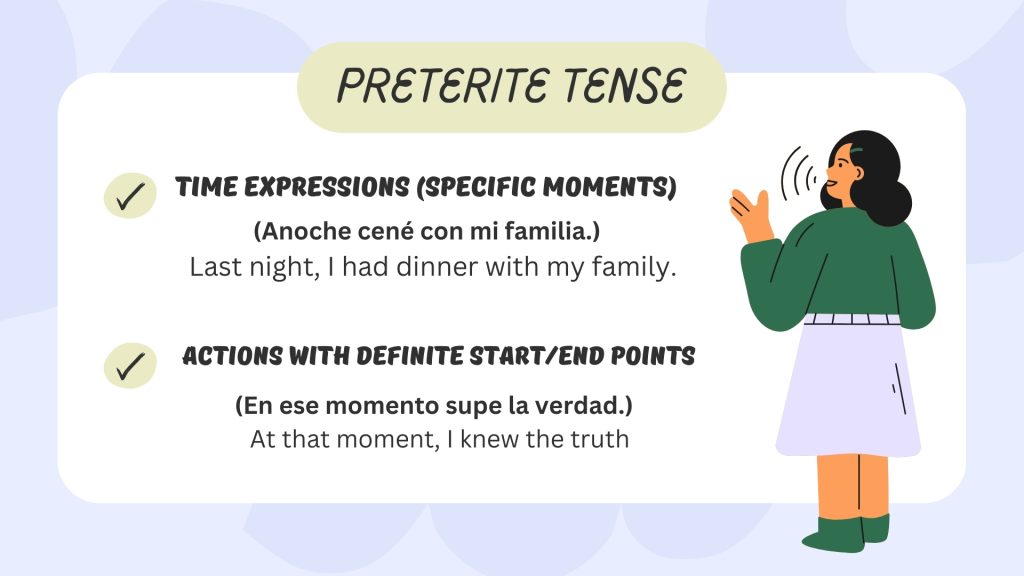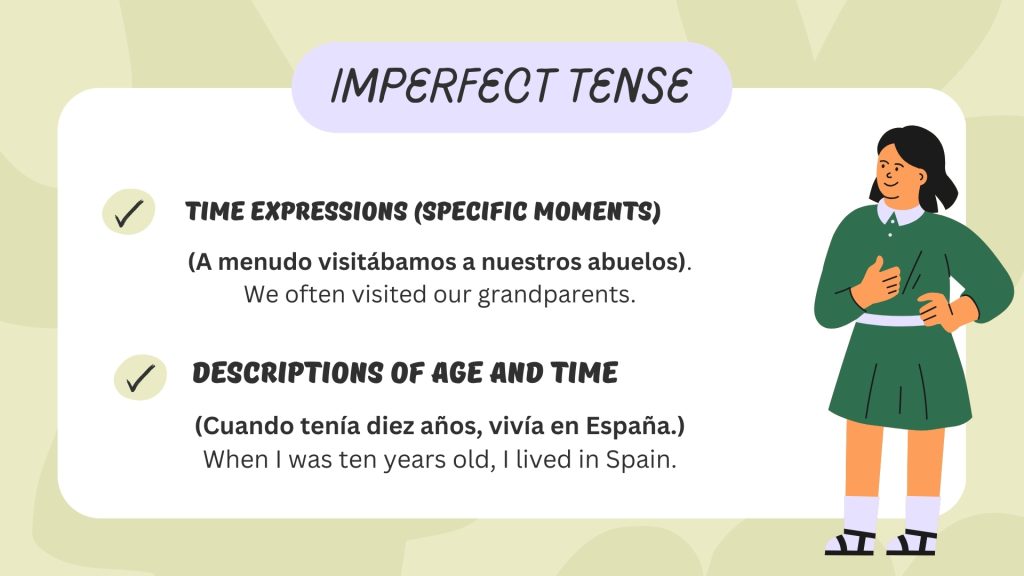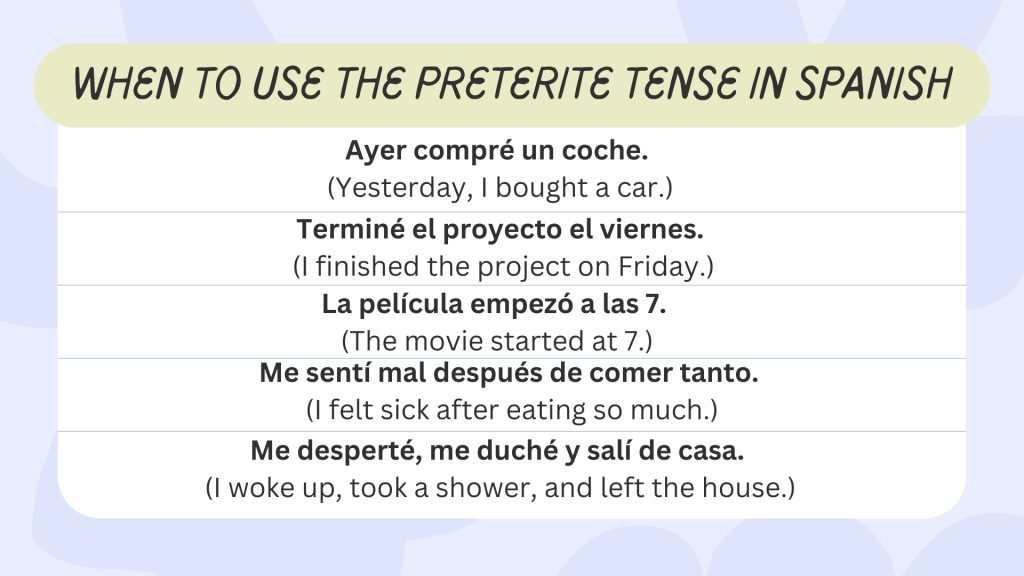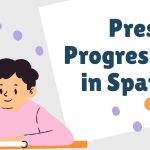When we dive into Spanish grammar, it’s crucial to understand the difference between the preterite and imperfect tenses. The preterite is used for actions that started and finished at specific times. It’s like saying, “This happened, then it was over.”
On the other hand, the imperfect tense talks about ongoing actions or routines in the past, without a clear end. It’s more like saying, “This used to happen” or “This was happening.”
These differences are not just grammar rules. They help us tell our stories better. By choosing the right tense, we can show whether something was a one-time deal or part of a bigger picture.
So, let’s think about how changing the tense can change the story we tell. It’s pretty interesting to see how a simple shift in tense can give a whole new feel to what happened.
Imperfect V/S Preterite
Knowing the difference between the imperfect and preterite tenses in Spanish really matters when you’re talking about the past. Use the preterite for actions that have a definite end. It’s like saying, ‘This happened, then it was over.’
| Difference | Imperfect ( Ongoing, Background) | Preterite ( Completed, Events) |
|---|---|---|
| The Movie vs. The Snapshot | Describes a scene, habits, or repeated actions. | A single, completed action. |
| Background vs. Headlines | Sets the scene (weather, time, emotions, descriptions). | Tells the main event or action. |
| “Used to” vs. “Did” | Expresses things that used to happen. | Expresses something that happened once. |
| Ongoing vs. One-Time | Action was in progress. | Action started and ended. |
| No Clear Start/End vs. Definite Time | No set start or finish. | Has a clear beginning or end. |
| Feelings vs. Actions | Describes emotions or mental states. | Actions or events that happened. |
| “While” vs. “Then” | Used with mientras (while) to show ongoing actions. | Used with entonces (then) for a sequence of events. |
| Childhood vs. One Day | Often used to describe childhood or past habits. | Used for specific past events. |
| Unfinished vs. Finished Story | Leaves things open-ended. | Tells a complete story. |
| Scene-Setting vs. Plot-Driving | Adds details to enrich the story. | Moves the story forward. |
On the other hand, the imperfect is for actions that kept going in the past or happened over and over. It sets the scene or shows habits. It’s like saying, ‘This was happening’ or ‘This used to happen.’
Useful Phrases that Trigger the Preterite
In Spanish, certain phrases tell you to use the preterite tense. This tense is for actions that are done and over with, within a specific time.

For example, ‘ayer’ means ‘yesterday’. ‘El otro día’ means ‘the other day’. ‘Una vez’ translates to ‘once’. And ‘el año pasado’ means ‘last year’.
When you hear these, you know the action happened at a definite time, which is perfect for the preterite.
| Spanish Phrase | English Meaning | Example Sentence |
|---|---|---|
| Ayer | Yesterday | Ayer fui al mercado. (Yesterday I went to the market.) |
| El otro día | The other day | El otro día vi una película genial. (The other day I watched a great movie.) |
| Anoche | Last night | Anoche cené con mis amigos. (Last night I had dinner with my friends.) |
| Hace (un año, una semana, etc.) | A (year, week, etc.) ago | Hace dos meses viajé a España. (Two months ago I traveled to Spain.) |
| De repente | Suddenly | De repente, empezó a llover. (Suddenly, it started to rain.) |
| En ese momento | At that moment | En ese momento, supe la verdad. (At that moment, I knew the truth.) |
| Por primera vez | For the first time | Por primera vez, probé sushi. (For the first time, I tried sushi.) |
| Entonces | Then | Estudié mucho y entonces aprobé el examen. (I studied a lot, and then I passed the test.) |
| Una vez | Once | Una vez conocí a un actor famoso. (Once, I met a famous actor.) |
| Finalmente / Al final | Finally / In the end | Finalmente, terminé el proyecto. (Finally, I finished the project.) |
Useful Phrases that Trigger the Imperfect
In Spanish, phrases like ‘every day’ or ‘when I was a child’ signal that you should use the imperfect tense. This tense shows actions that kept going or happened often in the past.

Other words like ‘always,’ ‘often,’ and ‘while’ also tell us that the action didn’t have a clear end. They help us see what normal life looked like back then.
| Spanish Phrase | English Meaning | Example Sentence |
|---|---|---|
| Siempre | Always | Siempre jugábamos en el parque. (We always played in the park.) |
| Todos los días / Cada día | Every day | Todos los días tomaba café por la mañana. (Every day, I drank coffee in the morning.) |
| A menudo | Often | A menudo visitábamos a mis abuelos. (We often visited my grandparents.) |
| De vez en cuando | From time to time | De vez en cuando, iba a la playa. (From time to time, I went to the beach.) |
| Mientras | While | Mientras cocinaba, escuchaba música. (While I was cooking, I was listening to music.) |
| Cuando era niño/a | When I was a child | Cuando era niño, tenía un perro. (When I was a child, I had a dog.) |
| Generalmente / Por lo general | Generally / In general | Por lo general, me acostaba temprano. (In general, I went to bed early.) |
| Frecuentemente | Frequently | Frecuentemente, leíamos cuentos antes de dormir. (We frequently read stories before bed.) |
| Cada verano / invierno | Every summer / winter | Cada verano, íbamos de vacaciones. (Every summer, we went on vacation.) |
| Antes | Before | Antes, vivíamos en otra ciudad. (Before, we lived in another city.) |
Make Spanish verb conjugation easy with our AR-ending verbs guide.
When to use the imperfect vs. the preterite
Knowing when to use the imperfect and preterite tenses in Spanish is key to speaking well about the past. The preterite is for actions that are done and happened at a specific time. The imperfect is for actions that kept going or happened often, and they don’t have a clear end point. This helps you tell stories about the past more clearly.
| Preterite | Imperfect |
|---|---|
| Ayer fui al cine. (Yesterday I went to the movies.) | Siempre iba al cine los domingos. (I always went to the movies on Sundays.) |
| El partido terminó a las 10. (The game ended at 10.) | El partido era emocionante. (The game was exciting.) |
| De repente, empezó a llover. (Suddenly, it started to rain.) | Llovía mientras caminábamos. (It was raining while we were walking.) |
| Supe la verdad ayer. (I found out the truth yesterday.) | Sabía la verdad desde hace años. (I had known the truth for years.) |
| Tuve un accidente. (I had an accident. – one-time event) | Tenía un coche rojo. (I used to have a red car.) |
Imperfect
In Spanish, the imperfect tense is used for actions that were ongoing or happened regularly in the past. This is different from the preterite tense, which is used for actions that started and finished at specific times.
The imperfect also helps set the stage in a story. It describes the situation or what was happening around the main events. Plus, it’s used to talk about someone’s age, the time, or what things were like back then.

Preterite
Understanding when to use the preterite and imperfect tenses in Spanish can really help you get your point across about past events. Think of the preterite as the go-to for completed actions. It tells you when things started and when they finished, perfect for listing events in order or pinpointing moments in time, like something that happened ‘last year.’
Now, let’s keep it simple. When you’re talking about what went down in the past, just remember: preterite is for the nitty-gritty details – the clear-cut beginnings and ends. It helps you set the scene with precise times.

Interaction of the preterite and the imperfect
In Spanish, using the preterite and imperfect tenses correctly is crucial to get the past right. The preterite is for specific events that started and finished. The imperfect, however, is used for ongoing situations or things that happened repeatedly.
| Interaction Type | Example Sentence | Meaning |
|---|---|---|
| An ongoing action (imperfect) interrupted by a completed action (preterite) | Yo estudiaba cuando mi amigo llegó. | I was studying when my friend arrived. |
| Background description (imperfect) + specific event (preterite) | Era un día lluvioso cuando salimos de casa. | It was a rainy day when we left the house. |
They help you tell a story clearly, showing what happened just once and what was part of a bigger picture or a routine. Understanding this helps make sense of past events.
Understand when and how to use the conditional tense in Spanish.
Verbs that have a Different Meaning in the Preterite and the Imperfect
In Spanish, the meaning of some verbs changes depending on the past tense used. For instance, when ‘saber’ is used in the preterite tense, it means ‘found out.’ But in the imperfect, it simply means ‘knew.’
Also, ‘querer’ in the preterite can mean ‘tried,’ but in the imperfect, it’s just ‘wanted.’ It’s really important to get these differences right to clearly talk about past events in Spanish.
| Verb | Preterite Meaning | Imperfect Meaning |
|---|---|---|
| Conocer | Met (for the first time) | Knew (was familiar with) |
| Saber | Found out / Discovered | Knew (information) |
| Querer | Tried | Wanted |
| No querer | Refused | Didn’t want |
| Poder | Managed to / Succeeded | Was able to |
| Tener | Got / Received | Used to have |
| Tener que | Had to (and did) | Had to (but uncertain if it happened) |
Conclusion
To put it simply, getting the hang of when to use the preterite and imperfect tenses in Spanish is really important if you want to talk about past events clearly. The preterite is for actions that are done and dusted, while the imperfect is for ongoing stuff or things you used to do regularly.
It’s all about picking up on the hints that tell you which tense to use. Plus, understanding how they fit into telling a story, and knowing those verbs that mean something different in each tense, can really boost your Spanish skills.
So, really getting these tenses down can make a big difference in how you share stories, be they from history or your own life.
Looking for more enriching content? Browse Lingua Viva now!
Carolina is a charming and lively member of Lingua Viva with 11+ years of teaching experience. She loves to teach students appropriate ways to communicate effectively in Spanish without the fear of making mistakes. She holds a professional teaching license and has a graduate degree with emphasis in Foreign Language.











